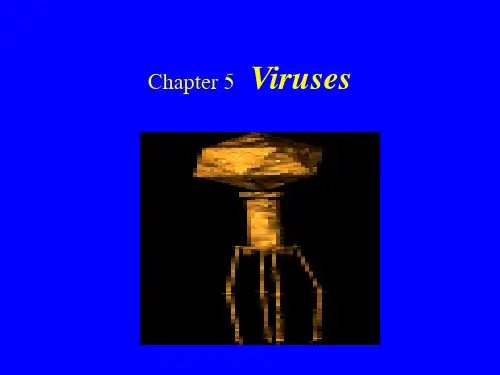微生物学英文课件3
- 格式:ppt
- 大小:2.71 MB
- 文档页数:42
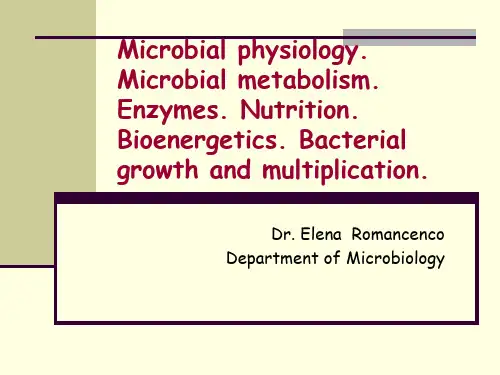



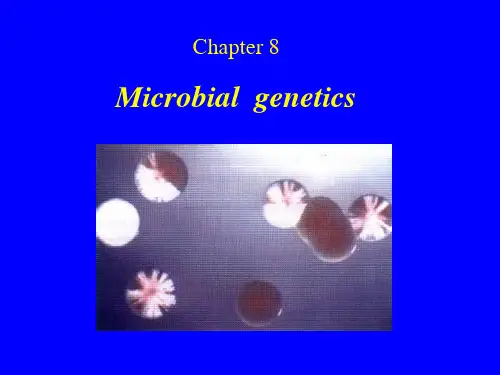
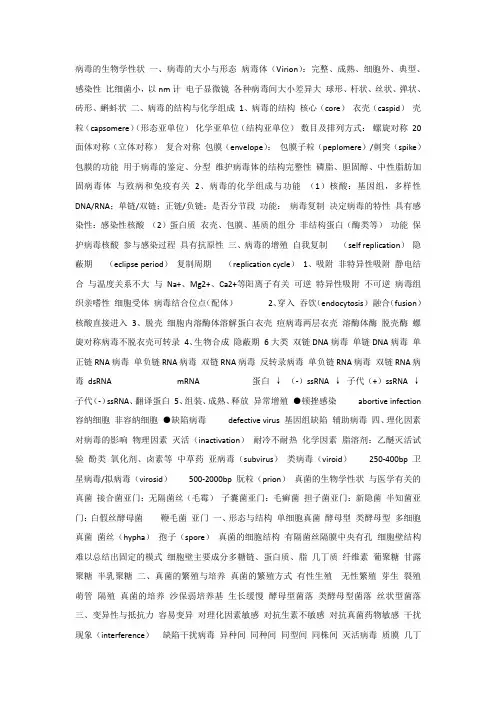
病毒的生物学性状一、病毒的大小与形态病毒体(Virion):完整、成熟、细胞外、典型、感染性比细菌小,以nm计电子显微镜各种病毒间大小差异大球形、杆状、丝状、弹状、砖形、蝌蚪状二、病毒的结构与化学组成1、病毒的结构核心(core)衣壳(caspid)壳粒(capsomere)(形态亚单位)化学亚单位(结构亚单位)数目及排列方式:螺旋对称20面体对称(立体对称)复合对称包膜(envelope):包膜子粒(peplomere)/刺突(spike)包膜的功能用于病毒的鉴定、分型维护病毒体的结构完整性磷脂、胆固醇、中性脂肪加固病毒体与致病和免疫有关2、病毒的化学组成与功能(1)核酸:基因组,多样性DNA/RNA;单链/双链;正链/负链;是否分节段功能:病毒复制决定病毒的特性具有感染性:感染性核酸(2)蛋白质衣壳、包膜、基质的组分非结构蛋白(酶类等)功能保护病毒核酸参与感染过程具有抗原性三、病毒的增殖自我复制(self replication)隐蔽期(eclipse period)复制周期(replication cycle)1、吸附非特异性吸附静电结合与温度关系不大与Na+、Mg2+、Ca2+等阳离子有关可逆特异性吸附不可逆病毒组织亲嗜性细胞受体病毒结合位点(配体)2、穿入吞饮(endocytosis)融合(fusion)核酸直接进入3、脱壳细胞内溶酶体溶解蛋白衣壳痘病毒两层衣壳溶酶体酶脱壳酶螺旋对称病毒不脱衣壳可转录4、生物合成隐蔽期6大类双链DNA病毒单链DNA病毒单正链RNA病毒单负链RNA病毒双链RNA病毒反转录病毒单负链RNA病毒双链RNA病毒dsRNA mRNA 蛋白↓(-)ssRNA ↓子代(+)ssRNA ↓子代(-)ssRNA、翻译蛋白5、组装、成熟、释放异常增殖●顿挫感染abortive infection 容纳细胞非容纳细胞●缺陷病毒defective virus 基因组缺陷辅助病毒四、理化因素对病毒的影响物理因素灭活(inactivation)耐冷不耐热化学因素脂溶剂:乙醚灭活试验酚类氧化剂、卤素等中草药亚病毒(subvirus)类病毒(viroid)250-400bp 卫星病毒/拟病毒(virosid)500-2000bp 朊粒(prion)真菌的生物学性状与医学有关的真菌接合菌亚门:无隔菌丝(毛霉)子囊菌亚门:毛癣菌担子菌亚门:新隐菌半知菌亚门:白假丝酵母菌鞭毛菌亚门一、形态与结构单细胞真菌酵母型类酵母型多细胞真菌菌丝(hypha)孢子(spore)真菌的细胞结构有隔菌丝隔膜中央有孔细胞壁结构难以总结出固定的模式细胞壁主要成分多糖链、蛋白质、脂几丁质纤维素葡聚糖甘露聚糖半乳聚糖二、真菌的繁殖与培养真菌的繁殖方式有性生殖无性繁殖芽生裂殖萌管隔殖真菌的培养沙保弱培养基生长缓慢酵母型菌落类酵母型菌落丝状型菌落三、变异性与抵抗力容易变异对理化因素敏感对抗生素不敏感对抗真菌药物敏感干扰现象(interference)缺陷干扰病毒异种间同种间同型间同株间灭活病毒质膜几丁质蛋白质层糖蛋白网葡聚糖粗糙卖孢菌细胞壁结构假菌丝叶状孢子芽生孢子厚膜孢子小孢子癣菌毛癣菌表皮癣菌分生孢子* * 病毒的形态核衣壳(nucleocaspid)包膜病毒和裸露病毒壳粒的排列方式螺旋对称壳粒壳粒的20面体对称复合对称与复杂对称电镜下的壳粒包膜病毒的刺突(3)脂类和糖吸附(absorption)穿入(penetration)脱壳(uncoating)生物合成(biosynthesis)组装、成熟、释放(assembly maturation and release)吸附双链DNA病毒(半保留复制)病毒DNA→转录早期mRNA →早期蛋白(酶类)→子代DNA →晚期mRNA →晚期蛋白(衣壳蛋白)单链DNA病毒ssDNA ↓dsDNA(RI)↓子代ssDNA、转录翻译单正链RNA病毒(+)ssRNA ↓早期蛋白(DRRP)↓(-)ssRNA ↓子代(+)ssRNA 晚期蛋白RNA RI 反转录病毒RNA ↓RNA:DNA中间体↓dsDNA→前病毒↓子代RNA、mRNA ↓翻译。
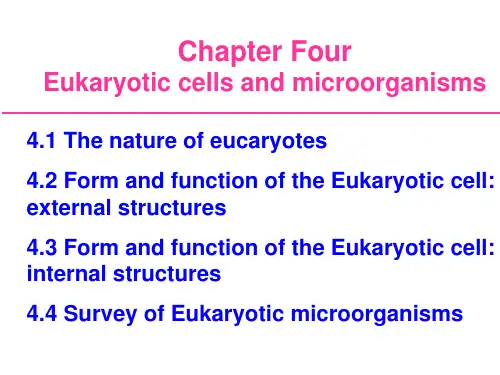
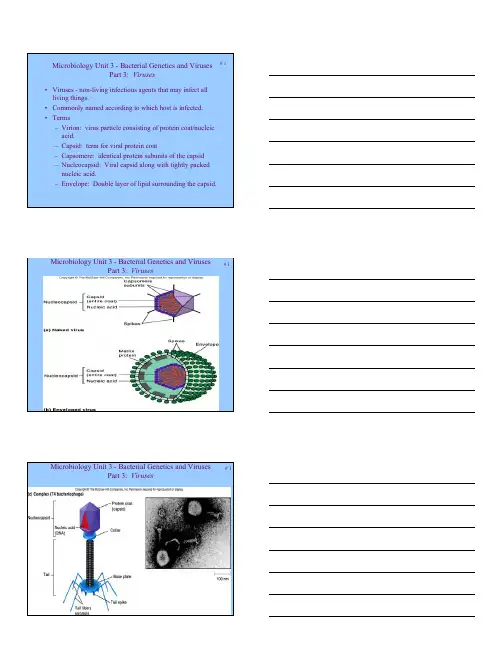
# 1 Microbiology Unit 3 -Bacterial Genetics and VirusesPart 3: Viruses•Viruses -non-living infectious agents that may infect all living things.•Commonly named according to which host is infected.•Terms–Virion: virus particle consisting of protein coat/nucleicacid.–Capsid: term for viral protein coat–Capsomere: identical protein subunits of the capsid–Nucleocapsid: Viral capsid along with tightly packednucleic acid.–Envelope: Double layer of lipid surrounding the capsid.Microbiology Unit 3 -Bacterial Genetics and Viruses# 1Part 3: VirusesMicrobiology Unit 3 -Bacterial Genetics and Viruses# 1Part 3: VirusesMicrobiology Unit 3 -Bacterial Genetics and VirusesPart 3: VirusesShape and Classification of RNA Viruses# 2 Shape and Classification of RNA Viruses# 2Shape and Classification of DNA Viruses # 2Relative Size of Viruses •Viruses 100-1000X smallerthan hosts: 10-500 nm.•Attachment via–Spikes (attachment proteinsproject from tailless capsid)–Tails (tail fibers used )–Not needed for plant viruses•Viral genome may be–Single or double stranded,DNA or RNA–DNA may be circular or linear–Very small genome.# 3/4/5Requirement for Viruses To Grow Inside Living Cells •Must have actively multiplying host cell for viral replication.•Viruses lack enzymes to make either enzymes or proteins.•Necessary to use host enzymes and cell structures for viral reproduction.•Two phases of viruses –Outside living cells: viruses are inert macromolecules –Inside living cells: viruses redirect host metabolism for viral reproduction.•Necessary Genetic Information Needed by Viruses –Viral protein coat –Replication for Viral nucleic acid–Movement of virus in and out of host.# 6# 7 Outcomes of Viral Infection of Bacteria1) Virulent or lytic phage, e.g.,T4–Redirect cell to make more phage and lyse the cell.2) Non-lytic phage, e.g.,filamentous phage -M13–Partial takover of cell metabolism to make more phagethen leak out into environment without killing cell.3) Temperate phage, e.g. Lambda (λ) phage–Produce “latent “ infections as they are incorporated intobacterial genome.–Replicate along with the host–Produce “lysogenic conversion” -coding for proteinsdifferent than those native to the host, e.g., C. diphtheriae Outcomes of Phage Infection of Bacteria# 7Bacterial Infection with Virulent TLytic Phage# 84Bacterial Infection with Temperate λ Phage# 9Transduction Review# 10•Bacterial gene transfer via bacteriophage.•General vs. specialized.–General: Any gene of the donor cell is transferred–Specialized:•Only selected genes from donor cell are transferred.•Only temperate phages are involved in transduction•Phage integrates at certain sites into the bacterialchromosome.•Examples are Lambda phage in E. coli and toxinproduction in Corynebacterium diphtheriaeGene Transfer in Bacteria -Transduction# 10Specialized Transduction Via Temperate Phage# 10 Virulent Properties Conferred to Bacterial HostsVia ProphageHost Ranges of Bacteriophage# 11•Host range of phage limited to specific bacterial species and often to only a few strains.•Important limitation factors:–Phage needs specific receptor sites on host cell surface•Receptor sites may be altered via mutation or lysogenic conversion.–Restriction modification system on host cell must be overcome •Host bacteria have 2 adjacent genes–Restriction enzyme–Modification enzyme.•Because of limited host range, DNA rarely transferred between species.。


